The World of Modern Electronics, Presented by the Transistor
Welcome to the World of Modern Electronics! We’ve got self-landing rocketships, drones that will deliver packages to your doorstep in minutes, and rovers scouring the farthest reaches of our galaxy. Without the famous transistor, none of these modern marvels would have ever been possible! Millions of these transistors are squeezed into the microprocessor powering your computer, but what in the world are they doing in there?
Let’s find out.
Just a Glorified Switch?
The transistor has been compared to the simple switch, but don’t be deceived; it’s much more than that. The transistor has two important jobs to accomplish, including:
Amplifying Current
A transistor can take a small current and turn it into a huge one! Think about hearing aids; they contain a miniature microphone that picks up sound from our everyday environment, which then gets gobbled up by a transistor and turned into a powerful sound that an ailing human ear can hear. My grandpa sends his regards, Transistor.
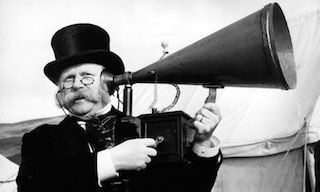
Oh my, how far the hearing aid has come, thanks to the transistor. (Image source)
Switching Current
Transistors also work as a powerful switch, allowing current to flow through only when specific conditions are met. When current is allowed to flow through, this creates an “on” state, or 1. When current can’t flow through, then the transistor is in an “off” state, or 0. This binary system of 1s and 0s form the building blocks to our World of Modern Electronics.
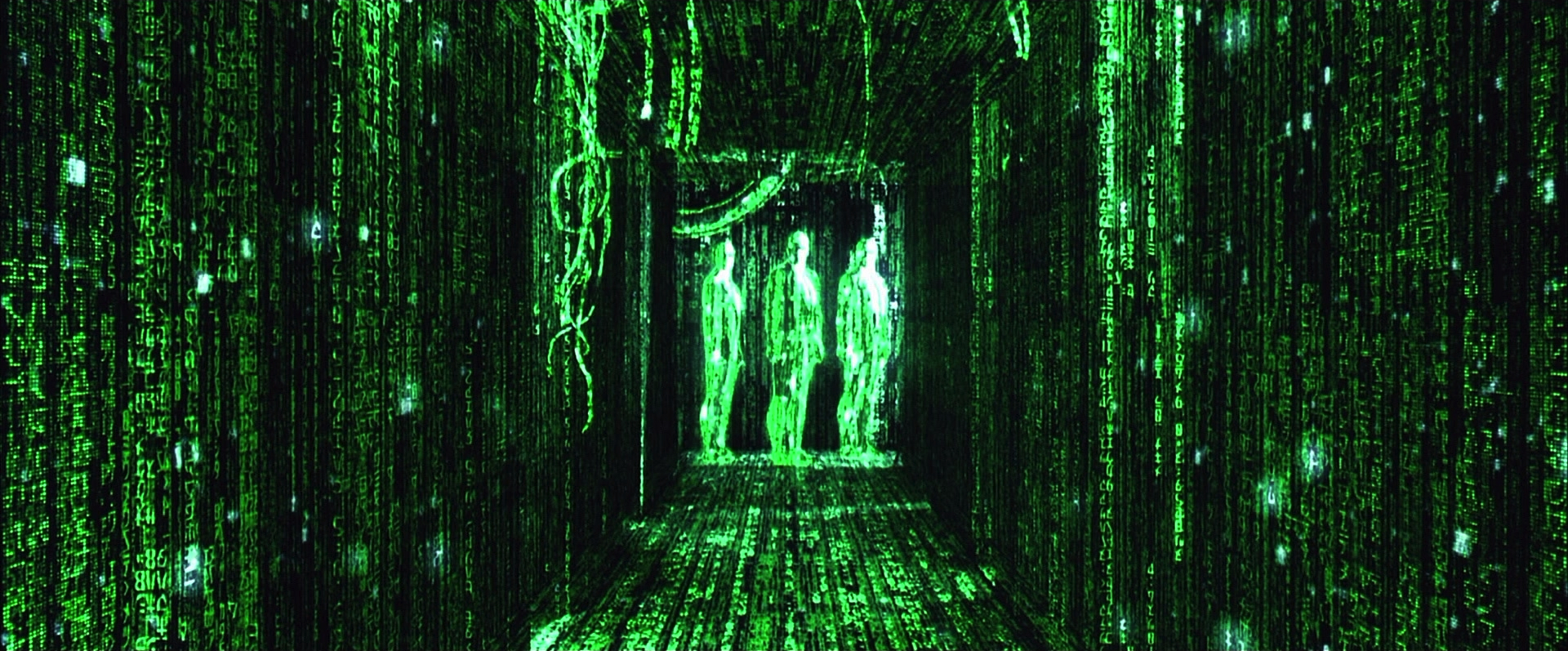
This famous scene from The Matrix takes on new life when you understand how transistors make it happen! (Image source)
Making the Transistor Work
If you combined two diodes, then you would get a transistor! Transistors have three terminals, each with their own specialized functions. For demonstration purposes, we will focus on an NPN transistor. We will explain more below.
- The Base. The base is responsible for controlling whether current is allowed to flow through the transistor when power is applied. You can think of him as the gatekeeper.
- The Collector. When there is power to the base, the collector current is allowed to flow towards the emitter.
- The Emitter. The emitter takes the electric current that the collector is allowed to send, to be used on other parts of your circuit.
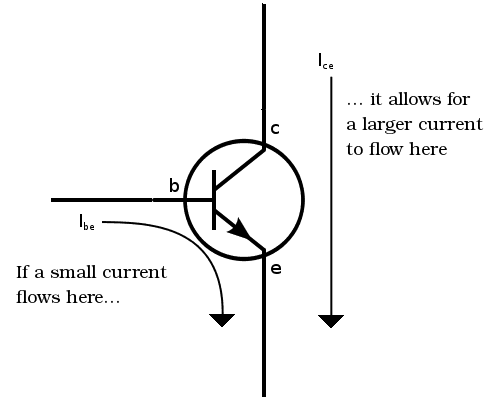
A simple flow to show how the base allows current to flow from the emitter to collector. (Image source)
The small amount of electrical current that the base receives opens the current flow from the collector to release its (larger) current. Dumping all the pent-up current to the emitter, powering other parts in your circuit.
But when you take away the source of current from the base, then no current will flow between the collector and the emitter. This process of both controlling current, as well as amplifying it between the base and emitter is what makes the transistor a truly one of a kind component.
Another Doped Component
Like its younger brother the diode, the transistor is another semiconductor component made from silicon. What’s a semiconductor? It’s a material that sits somewhere in the middle of being a conductor (a material that electricity likes to flow through) and an insulator (a material that electricity avoids). Sounds like a case of indecision, right?
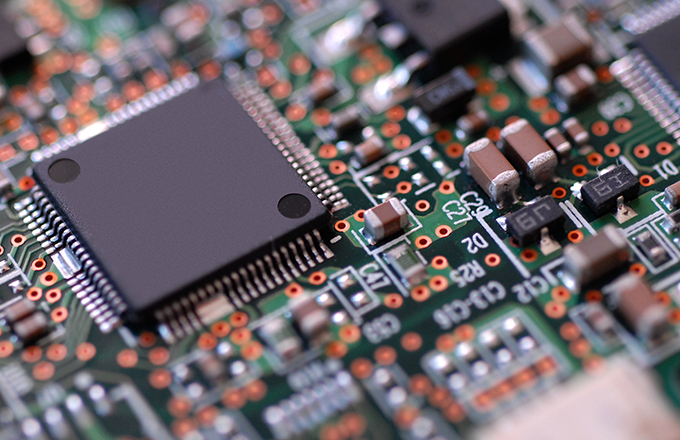
Semiconductors come in a variety of shapes and sizes in their manufactured forms, like this integrated circuit. (Image source)
By adding impurities to semiconductors, known as doping, we’re able to make this these materials behave in unique ways. For example:
- Creating N-Type Silicon. Doping silicon with the chemical element arsenic, phosphorous, or antimony will give our silicon extra electrons, allowing it to carry an electric current. This creates n-type silicon.
- Creating P-Type Silicon. Doping silicon with the chemical elements boron, gallium, or aluminum robs our silicon of its free electrons, attracting outside electrons. This creates p-type silicon.
- Creating Transistors. When you put these two types of silicon together, transistors are born! These are combined into a “silicon sandwich” that allows current to flow in some interesting ways.
We now have our raw ingredients for a transistor, n-type silicon and p-type silicon, but how do they come together to form this component? There are two ways to construct a transistor:
NPN Transistors
These transistors are created when you put three layers of silicon together, including two n-type silicon and one p-type silicon. The n-types serve as the collector and emitter, and the p-type serves as the base. This all comes together to form what’s called an NPN transistor. In these transistors, electrons pass from the emitter to the collector once given the go-ahead from the base.
PNP Transistors
These transistors are born when you combine another three layers of silicon together, only in a different combination. In this case, we have two p-type silicons and one n-type silicon. This combination creates the reverse effect of an NPN transistor, where instead of sending current to the emitter, a collector sends positively charged “holes” to the collector. You can think of these holes as basically empty, contained spaces with no electrons in them.
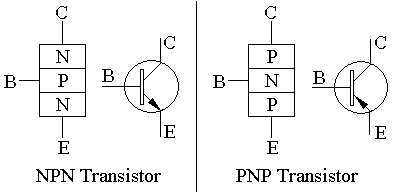
A simple way to visualize how silicon is stacked together in a transistor.
Transistor Types You’ll Encounter
During your journey in the world of electronics, you’re bound to run into two primary types of transistors – the Bipolar Junction Transistor (BJT) and Field Effect Transistor (FET). Let’s take a look at each:
Bipolar Junction Transistor (BJT)
This is the transistor that we have been talking about in all of our examples. It comes in two versions, NPN and PNP, and has three terminals, a base, emitter, and collector. Does the schematic symbol below look familiar? If the diode came to mind, then you are getting close! Junction transistors will have their three terminals labeled, with an arrow showing which direction the current will flow.
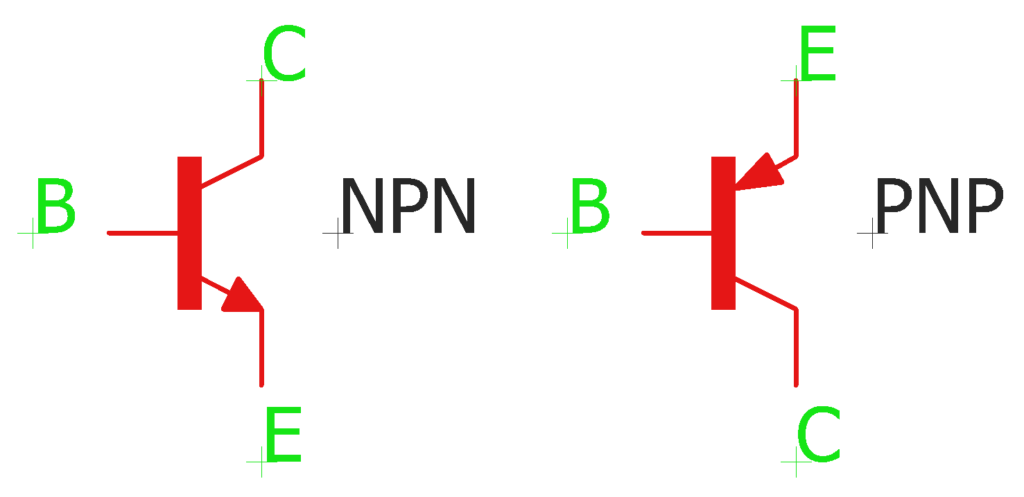
An NPN and PNP transistor, notice how the arrow shows the flow of current for each.
In an NPN transistor, all you need is a voltage of about 0.7V applied to the base to get a huge surge of current flowing through the collector to the emitter. This will turn the transistor “on,” creating a 1 in binary.
Field-Effect Transistor (FET)
The field-effect transistor came into existence after the BJT, and while it has three terminals, they’re named a little differently. You have your gate, which is similar to a base, a source, which is analogous to a collector, and lastly a drain, which is like an emitter. This transistor type also includes layers of n-type and p-type silicon, but they’re coated with layers of metal and oxygen ions, which gives this transistor the unique name of MOSFET (Metal Oxide Semiconductor Field Effect Transistor). That’s a mouthful!
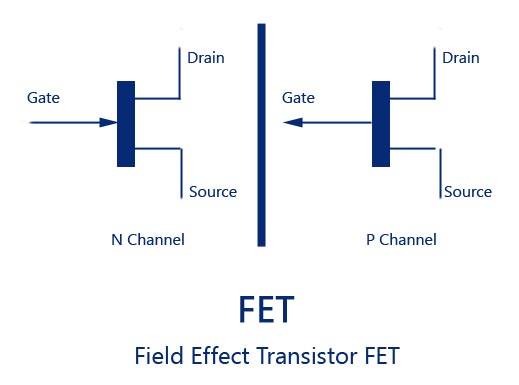
Two types of FET transistors, n-channel and p-channel. (Image source)
In this type of transistor, attaching a positive voltage to the gate will allow electrons to flow through a very thin channel between the source and drain. And while this process is visually different, it’s the same basic principle of a small amount of current allowing a larger source of current to flow.
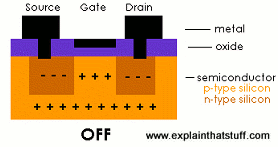
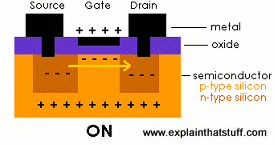
Egos and the Birth of the Transistor
The invention originated in the depths of Bell Laboratories in New Jersey by three physicists, John Bardeen, Walter Brattain, and William Shockley. The team was brought together under the lead of Shockley to develop a replacement for the unreliable vacuum tube that was in use to amplify signals for the US telephone system.
Things get ugly with this trio.
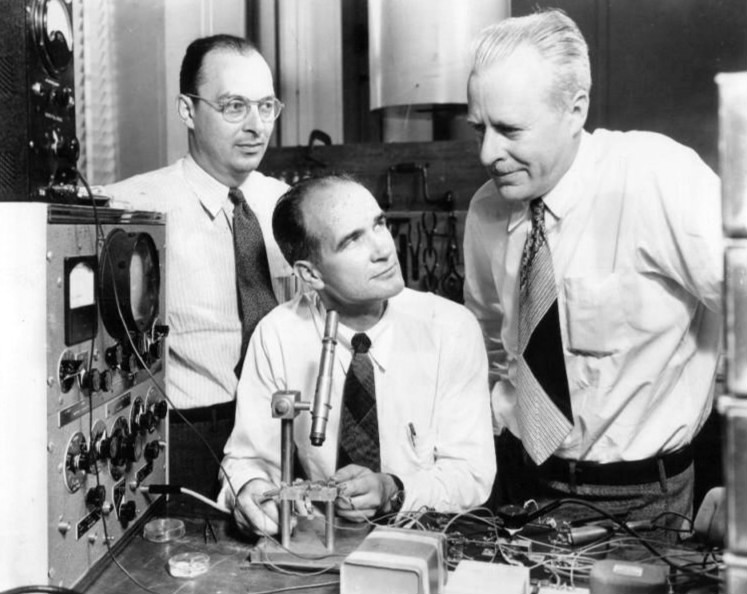
The three brilliant physicists are at work to develop a replacement to the vacuum tube. (Image source)
First, both Bardeen and Brattain went off to work on their own, creating what we now know as the first point-contact transistor on December 16, 1947. They intentionally left Shockley out of the entire process, and maybe for a good reason, as he was reportedly a bit of a jerk.
Of course, Shockley was upset for being left out, so what did he do? He locked himself in a hotel room for several days with pencil and paper and later walked out with the theory for the now famous junction transistor, which was much more manufacturable than the point-contact transistor.
Shockey – 1, Bardeen & Brattain – 0.

The not so glamorous first transistor created on a slab of germanium. (Image source)
At the end of the day, all three of these gentlemen went on to receive credit for the invention of the transistor. Shockley even went on to form his own semiconductor company, Shockley Semiconductor Laboratory, and after a rough falling out with some of his employees, Intel and Fairchild Semiconductor were born in the aftermath of Shockley’s company.
Bell Labs and Beyond
Since its birth at Bell Labs, the transistor has gone on to have a wild and crazy history. Manufacturable transistors were used as amplifiers, and it’s during the year of 1952 that the first transistor hearing aids become available. But this didn’t quite win over manufacturers and consumers, who still saw the vacuum tube technology as the only amplifying option.
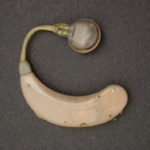
Check out the size differences! The first transistor hearing aid (Top) and vacuum tube hearing aid (Bottom). (Image source)
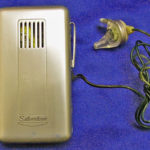
This perception soon changed when transistors entered the radio. Sounds could be sent through a microphone, turned into an electrical circuit, and amplified by a transistor to produce some pretty amazing sounds in such a small package.
The real nail in the coffin for vacuum tubes came in the form of a pocket-sized radio developed by Texas Instruments in 1954, named the Regency TR-1. This miniaturized radio required several new parts to fit inside such a small case, including carefully engineered speakers, capacitors, and of course, transistors.
The benefit of all of this engineering?
Texas Instruments proved that transistors could be mass-produced and economical. And companies like Emerson, General Electric, and Raytheon finally began to take the transistor seriously.
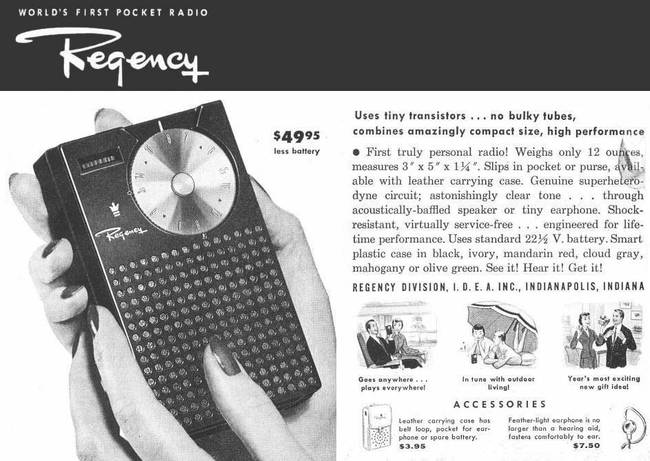
The world’s first pocket radio, made possible by the transistor. (Image source)
1954 signaled the replacement of silicon as the material of choice for transistor production, which was found to be more reliable and less expensive to produce than germanium-based transistors. The advancements continued throughout the 60s, and in the 1970s the first MOSFET transistor appeared, building on the success of the junction transistor from William Shockley.
What does the future hold for transistors?
Well, that remains to be seen. Scientists are currently working on the world’s first molecular transistor, made from a single benzene molecule. This type of transistor doesn’t create nearly as much wasted heat as our present day silicon transistors.
We’re also attempting to replace silicon with graphene, which can transfer electrons much quicker than silicon. The only hangup? We still can’t figure out how to reliably manufacture graphene. If we can get it working at a reasonable cost, graphene will make our computer processors 1,000 times faster than silicon.
The Transistors Role in Computing
Let’s bring things back to the present to understand how transistors have completely changed computers in two areas – logic and memory.
Transistors and Logic
By putting many transistors together, you can make something called a logic gate. This allows you to compare incoming currents, and send out different outputs depending on your programmed logic.
These logic gates allow a computer to make decisions with the help of Boolean algebra. If you’ve dabbled in programming, then these should be familiar, including booleans like AND, OR, NOT, etc… Combining all of this logic together is what makes our computer software run, providing a series of instructions for our computers to carry out.
Transistors and Memory
Transistors are also used to power all of the memory in our computers. By hooking up logic gates in a particular pattern, you can create output connections that feedback into input connections. This creates a kind of pattern where transistors will stay on even after their base current is removed, leaving a transistor in what’s called a stable state on or off state. Multiply this by millions or billions of stable state transistors, and you soon find yourself with an arrangement of constantly on and off transistors that can store data as both 1s and 0s.
Smaller They Go, But Where They’ll Stop, Nobody Knows!
For only coming into existence around 70 years ago, transistors have had a heck of a ride, growing from dozens to hundreds and now even millions and billions of transistors in our everyday computing devices! These semiconductor components round out our look into the fascinating world of active components that play a dynamic role in the growth of our electronic designs.
Can we continue to pack in more and more transistors in our integrated circuits as Moore’s Law states? We’re starting to hit the physical limits of silicon and electrons. It looks like it’s time to pour some R&D money into graphene and photons. The World of Modern Electronics awaits!
Did you know that Autodesk EAGLE has a ton of free transistor libraries that are ready for you to use? Try Autodesk EAGLE for free today to get started!
